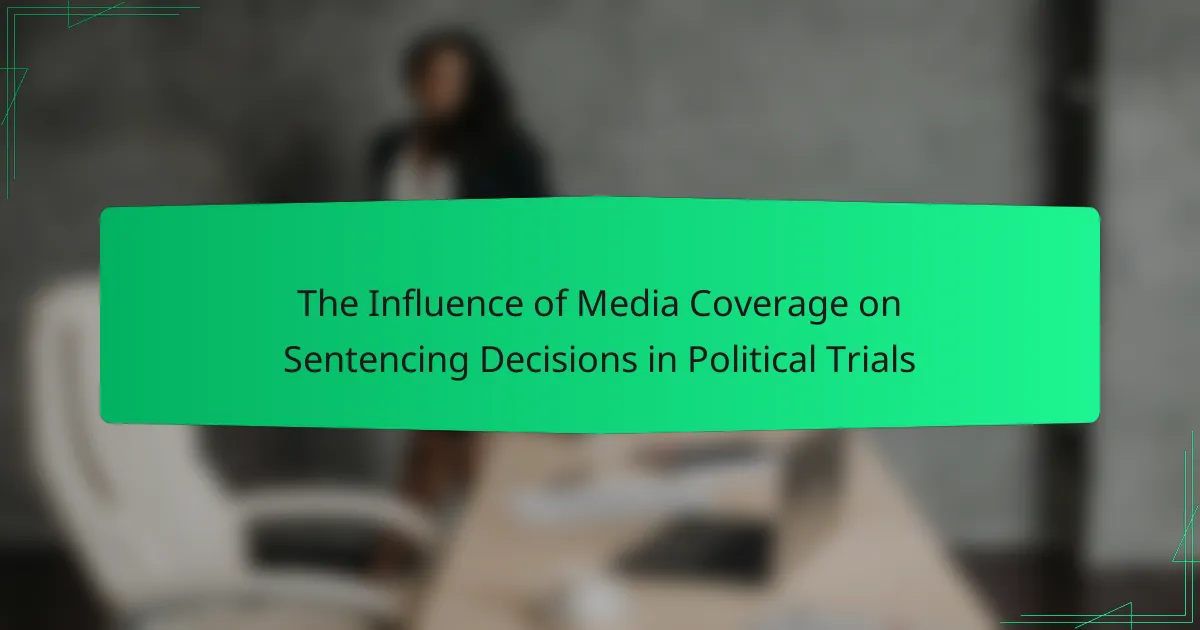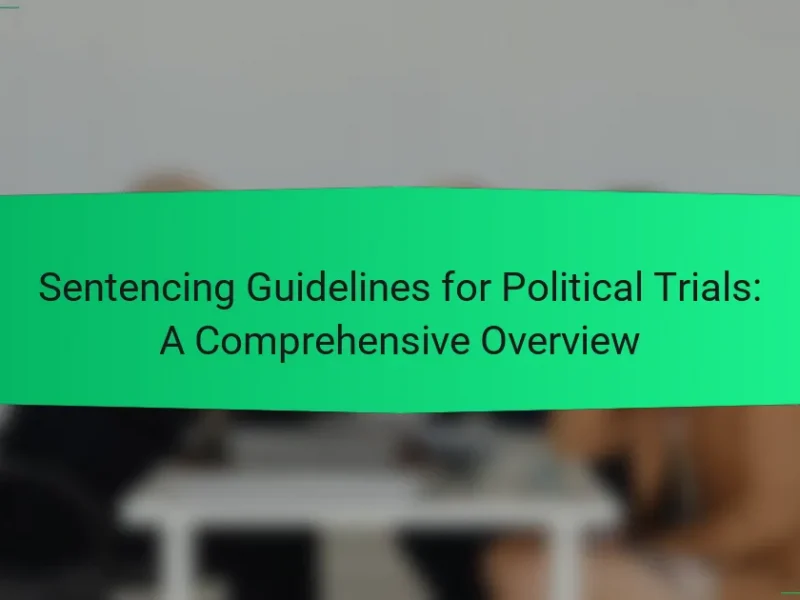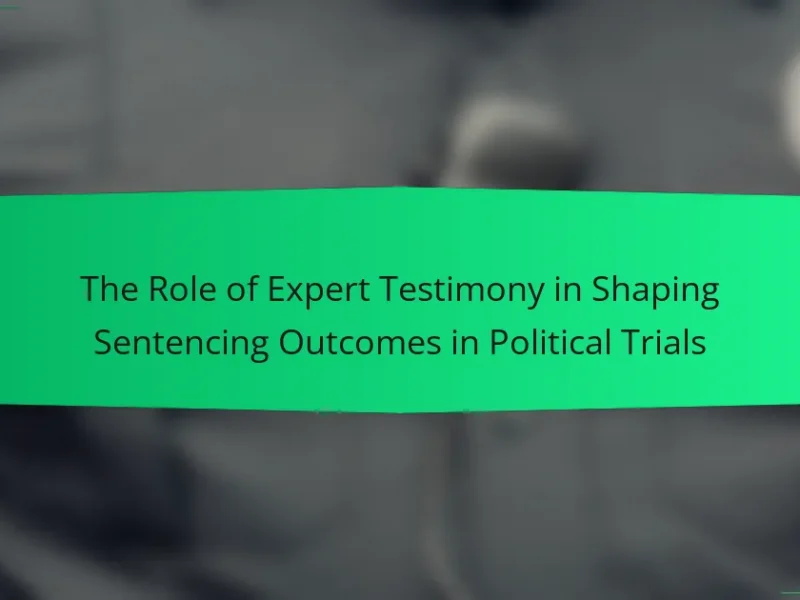Media coverage significantly impacts sentencing decisions in political trials, influencing public perception and creating pressure on judicial outcomes. High-profile cases often attract extensive media attention, leading to increased scrutiny of judges and juries. Research indicates that sensationalized reporting can bias jurors against defendants, while judges may feel compelled to align their sentences with public sentiment. This dynamic can result in harsher penalties in politically charged cases, ultimately undermining the integrity of the judicial process. The article explores the mechanisms through which media coverage shapes public opinion, jury bias, and judicial pressure, highlighting the implications for fair trial standards.
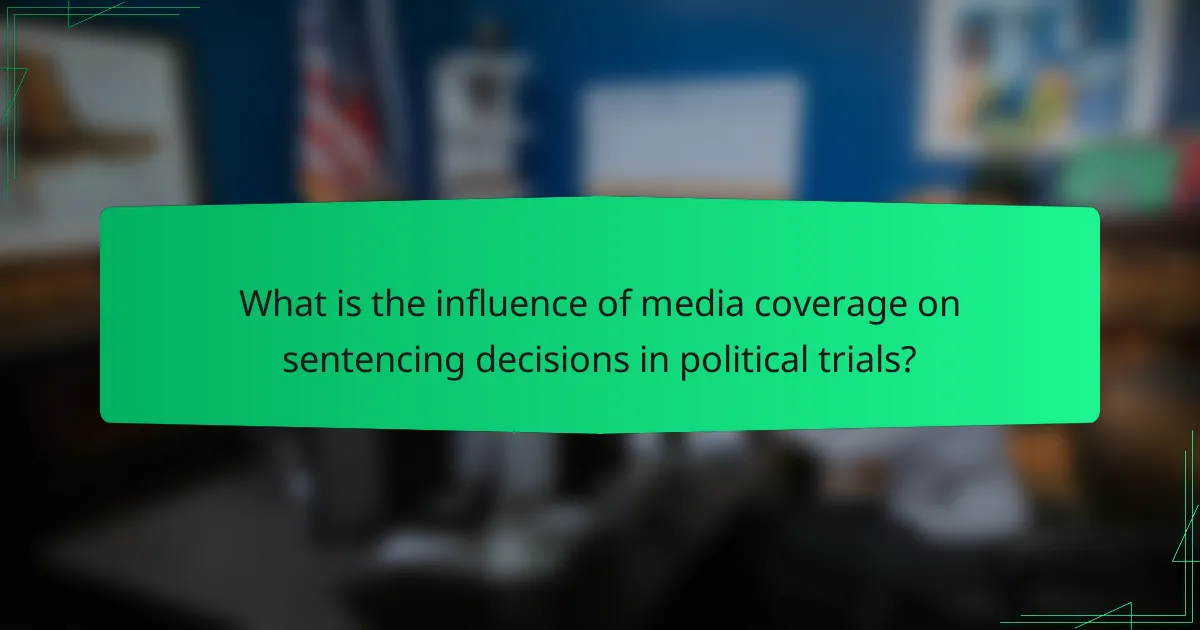
What is the influence of media coverage on sentencing decisions in political trials?
Media coverage significantly influences sentencing decisions in political trials. The presence of media can shape public perception and create pressure on judicial outcomes. High-profile cases often receive extensive media attention. This can lead to increased scrutiny of judges and juries. Research shows that media portrayal can sway opinions about the defendant’s guilt. For instance, sensationalized reporting may bias jurors against the accused. Studies indicate that judges may feel compelled to align their sentences with public sentiment. This dynamic can result in harsher penalties in politically charged cases. Overall, media coverage plays a crucial role in shaping the judicial process in political trials.
How does media coverage shape public perception of political trials?
Media coverage significantly shapes public perception of political trials. It influences how the public interprets the events, key figures, and outcomes of these trials. Coverage can highlight specific narratives, framing them in a way that sways public opinion. For instance, sensational reporting may evoke strong emotional responses, while balanced reporting can foster critical analysis. Studies show that extensive media coverage correlates with increased public interest and engagement in political trials. Furthermore, the portrayal of defendants and their actions can lead to biases, impacting the perceived legitimacy of the trial. In high-profile cases, the media’s role in shaping narratives can lead to preconceived notions before the trial concludes. This underscores the media’s power in influencing public discourse surrounding political justice.
What role does sensationalism play in media reporting of political trials?
Sensationalism plays a significant role in media reporting of political trials. It often amplifies emotions and dramatizes events to attract audience attention. This approach can skew public perception of the trial. Sensationalized coverage may lead to biased interpretations of evidence and testimonies. Research indicates that sensationalism can influence juror attitudes and decisions. For example, studies show that jurors exposed to sensational media may lean towards harsher sentencing. This effect underscores the importance of responsible media reporting. Sensationalism can ultimately shape the narrative surrounding political trials, impacting justice outcomes.
How does the framing of news stories affect juror opinions?
The framing of news stories significantly affects juror opinions. Jurors are influenced by how information is presented in the media. Specific wording, tone, and context can shape perceptions of guilt or innocence. For instance, a story emphasizing a defendant’s criminal background may lead jurors to view them more negatively. Conversely, framing that highlights mitigating circumstances can foster sympathy. Research shows that jurors exposed to biased media coverage are more likely to render harsher verdicts. A study by the American Psychological Association found that jurors’ decisions can be swayed by the emotional tone of news reports. This demonstrates the powerful role of media framing in legal contexts.
Why is media coverage significant in the context of political trials?
Media coverage is significant in political trials because it shapes public perception and influences judicial outcomes. Extensive media attention can create a narrative that impacts how the trial is viewed by the public and jurors. This can lead to increased pressure on judges and juries to conform to public opinion. Studies show that high-profile cases receive different treatment based on media portrayal. For instance, the coverage of the O.J. Simpson trial influenced public sentiment and perceptions of justice. Furthermore, media coverage can affect the behavior of legal professionals involved in the trial. Overall, the relationship between media and political trials is complex and impactful.
What impact does media exposure have on the fairness of trials?
Media exposure can significantly impact the fairness of trials. It can lead to biased perceptions among jurors and the public. Pre-trial publicity may influence jury selection and decision-making processes. Research indicates that excessive media coverage often results in a presumption of guilt before a trial begins. A study published in the Journal of Criminal Justice found that jurors exposed to media coverage were more likely to convict. This suggests that media can distort the impartiality expected in legal proceedings. Consequently, the integrity of the judicial process may be compromised due to external media influence.
How does media coverage influence the behavior of legal professionals?
Media coverage significantly influences the behavior of legal professionals. Legal professionals often adjust their strategies based on public perception shaped by media narratives. High-profile cases attract extensive media attention, leading attorneys to be more cautious in their public statements. This caution stems from the potential impact of media on jury opinions and public sentiment. Studies show that sensationalized reporting can create biases, prompting legal professionals to modify their approaches to avoid negative repercussions. For instance, a 2019 study published in the Journal of Legal Studies found that attorneys in politically charged cases were more likely to seek media training to manage their public image. Thus, media coverage can lead legal professionals to adopt more strategic and measured behaviors in their practice.
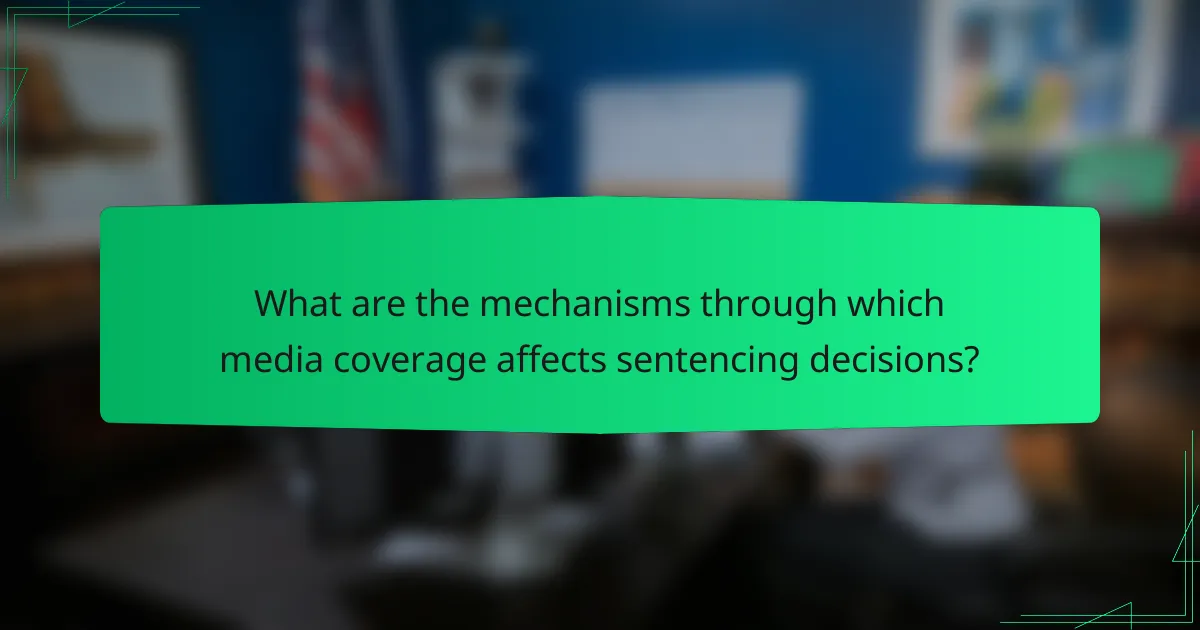
What are the mechanisms through which media coverage affects sentencing decisions?
Media coverage influences sentencing decisions through various mechanisms, including public opinion shaping, jury bias, and judicial pressure. Public opinion can be swayed by sensationalized reporting, leading to heightened emotional responses from jurors. Studies show that jurors exposed to extensive media coverage may feel compelled to align their verdicts with perceived public sentiment. Additionally, media narratives can create biases, portraying defendants in a negative light and impacting jury impartiality. Judicial pressure may arise when judges consider community reactions, fearing backlash if sentences do not align with public expectations. Research indicates that cases with high media visibility often result in harsher sentences due to these intertwined factors.
How do different types of media coverage impact trial outcomes?
Different types of media coverage significantly impact trial outcomes. Positive media coverage can lead to public support for defendants. This can influence jurors’ perceptions and potentially result in more favorable verdicts. Conversely, negative media coverage often creates public bias against defendants. This can increase the likelihood of conviction and harsher sentencing. Research indicates that sensationalist reporting can distort public opinion and jury impartiality. For example, a study by the American Psychological Association found that pre-trial publicity affects juror decision-making. This demonstrates the powerful role media plays in shaping trial dynamics.
What differences exist between traditional media and social media in influencing sentencing?
Traditional media and social media differ significantly in influencing sentencing. Traditional media, such as newspapers and television, often provide curated content with editorial oversight. This content typically reflects established journalistic standards and can shape public opinion through in-depth analysis. In contrast, social media platforms allow for immediate, unfiltered communication. Users can share opinions rapidly, leading to viral narratives that may not undergo fact-checking.
The impact of traditional media is often slower, as it relies on scheduled news cycles. Conversely, social media can create instant public outcry, which may pressure legal systems. Studies indicate that high-profile cases receive more attention on social media, amplifying public sentiment. This phenomenon can lead to increased scrutiny of sentencing outcomes, sometimes resulting in harsher penalties influenced by online discourse.
Overall, traditional media tends to influence sentencing through structured reporting, while social media exerts pressure through rapid, widespread engagement.
How does the timing of media coverage correlate with trial phases?
The timing of media coverage correlates with trial phases by influencing public perception and legal outcomes. During pre-trial phases, media coverage can shape narratives and create biases. For instance, extensive coverage can lead to heightened public scrutiny and pressure on legal entities. In trial phases, real-time reporting can affect juror opinions and courtroom dynamics. Research shows that media attention peaks during key moments, such as opening statements and verdict announcements. This pattern indicates that the timing of coverage can significantly impact the perceived fairness of the trial process. Studies have documented that increased media scrutiny often correlates with harsher sentencing outcomes in political trials.
What psychological effects does media coverage have on jurors and judges?
Media coverage can significantly influence the psychological state of jurors and judges. Jurors may experience heightened anxiety due to public scrutiny. This anxiety can lead to decision-making that aligns with perceived community expectations. Judges may feel pressure to deliver verdicts that reflect public sentiment. This pressure can compromise their impartiality. Studies show that extensive media coverage can create biases. For example, jurors may be swayed by sensationalized narratives. Judges might also be influenced by the media portrayal of cases. This can result in harsher sentences to appease public opinion. Overall, media coverage can distort the judicial process by introducing external psychological pressures.
How does exposure to media narratives shape juror biases?
Exposure to media narratives significantly shapes juror biases. Media coverage can influence jurors’ perceptions of a case before they enter the courtroom. This exposure often leads to preconceived notions about the defendant’s guilt or innocence. Research indicates that jurors may rely on media portrayals when making decisions. For example, studies show that sensationalized reporting can skew jurors’ views. This can result in harsher judgments or leniency based on the narrative presented. Furthermore, repeated exposure to certain themes can create confirmation biases among jurors. These biases can ultimately affect trial outcomes and sentencing decisions.
What are the implications of media-induced stress on judicial decision-making?
Media-induced stress can significantly impact judicial decision-making. This stress may lead judges to feel pressure from public opinion. As a result, their decisions may become influenced by media portrayals rather than legal facts. Research indicates that heightened media scrutiny can create a fear of backlash among judges. This fear may cause them to impose harsher sentences to align with perceived public expectations. A study published in the Journal of Law and Politics found that judges exposed to intense media coverage tend to prioritize popular sentiment over legal principles. Consequently, media-induced stress can compromise the integrity of judicial outcomes.
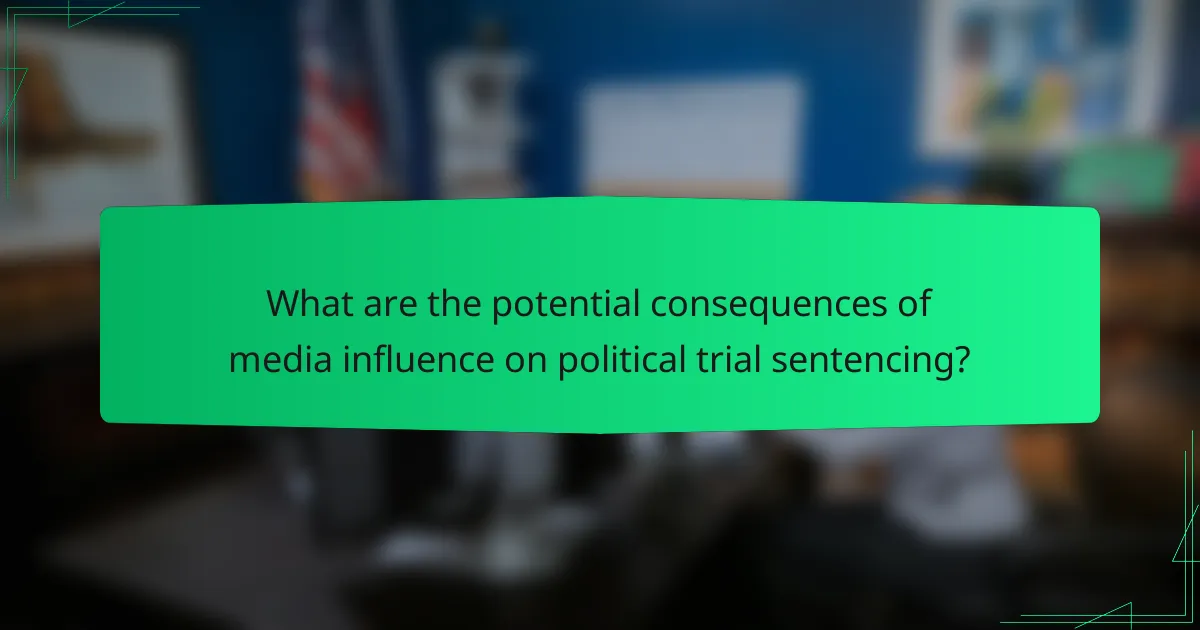
What are the potential consequences of media influence on political trial sentencing?
Media influence on political trial sentencing can lead to biased outcomes. This bias may stem from public opinion shaped by sensationalized reporting. Media coverage can create a narrative that pressures judges and juries. This pressure may result in harsher sentences to align with public sentiment. Studies show that high-profile cases often receive disproportionate media attention. This attention can skew perceptions of guilt before a trial begins. Consequently, defendants may face challenges in receiving a fair trial. Overall, media influence can undermine the integrity of the judicial process.
What ethical considerations arise from media coverage of political trials?
Media coverage of political trials raises several ethical considerations. One primary concern is the potential for bias in reporting. Biased coverage can influence public perception and undermine the fairness of the trial. Another issue is the presumption of innocence. Media portrayal can lead to premature judgments about the accused before legal proceedings conclude. Additionally, sensationalism in reporting can distort facts and create public hysteria. This can pressure legal systems to deliver harsher sentences due to public outcry. Privacy concerns also arise, as media may disclose sensitive information about defendants and witnesses. Ethical journalism requires balancing public interest with respect for individual rights. Overall, these considerations highlight the responsibility of media in shaping narratives around political trials.
How can media accountability be ensured to protect judicial integrity?
Media accountability can be ensured through strict regulations and ethical standards. Establishing clear guidelines for reporting on judicial matters is essential. Media organizations should implement internal review processes to assess the accuracy of their coverage. Training journalists on the legal implications of their reporting can also enhance accountability. Transparency in media practices promotes public trust and mitigates bias. Independent oversight bodies can monitor media adherence to established standards. Historical cases demonstrate that responsible media practices contribute to fair judicial processes. For instance, the American Bar Association emphasizes the importance of ethical reporting in maintaining the integrity of the legal system.
What are the risks of media sensationalism in the context of justice?
Media sensationalism in the context of justice can lead to significant risks. It often distorts public perception of legal proceedings. This distortion can result in biased opinions about defendants and victims. Sensationalized coverage may influence jury decisions, undermining fair trial principles. Research shows that high-profile cases receive disproportionate media attention, which can skew the public’s understanding of the facts. For instance, studies indicate that jurors exposed to sensational media reports may be more likely to convict. Additionally, sensationalism can pressure legal authorities to act in a manner that aligns with public outcry rather than justice. This can lead to rushed investigations and inadequate legal representation. Ultimately, media sensationalism threatens the integrity of the judicial process.
What best practices can be implemented to mitigate media influence on sentencing?
Implementing best practices to mitigate media influence on sentencing involves several strategies. Courts can issue gag orders to limit pre-trial publicity. This helps ensure that jurors are not swayed by external media narratives. Judges can also instruct jurors to avoid media coverage related to the case. Clear guidelines on discussing the trial can reduce potential biases. Additionally, utilizing jury sequestration can further shield jurors from outside information. Research indicates that jurors exposed to media coverage may have skewed perceptions of guilt. By controlling the flow of information, the integrity of the trial process is preserved. These practices are essential for maintaining fair sentencing outcomes.
How can legal teams prepare for media scrutiny during trials?
Legal teams can prepare for media scrutiny during trials by developing a comprehensive communication strategy. This strategy should include designated spokespersons trained to handle media inquiries. Legal teams should also prepare key messages that clearly convey their position and facts of the case. They must anticipate potential questions and scenarios that may arise in media coverage. Monitoring media coverage in real-time allows teams to respond swiftly to inaccuracies. Additionally, legal teams should engage with public relations experts to enhance their messaging. By establishing a proactive approach, they can mitigate negative media impacts. Studies show that effective communication can influence public perception and, ultimately, trial outcomes.
What strategies can jurors use to remain impartial despite media coverage?
Jurors can use several strategies to remain impartial despite media coverage. They should avoid consuming news related to the case. This helps prevent preconceived notions from forming. Jurors can also focus solely on the evidence presented in court. This ensures their decisions are based on facts. Additionally, jurors should adhere to judicial instructions regarding media exposure. Courts often provide guidelines to minimize bias. Engaging in discussions with fellow jurors about the case can also help maintain objectivity. This allows jurors to share perspectives and reinforce impartiality. Lastly, jurors can remind themselves of their duty to deliver a fair verdict. This commitment to justice can counteract external influences.
The main entity of the article is the influence of media coverage on sentencing decisions in political trials. The article examines how media coverage shapes public perception, affects juror opinions, and creates pressure on judges, potentially leading to biased outcomes and harsher penalties. It discusses the role of sensationalism in media reporting, the psychological effects on jurors and judges, and the implications for judicial integrity. Additionally, it outlines best practices for mitigating media influence and emphasizes the importance of responsible reporting to ensure fair trial processes.
